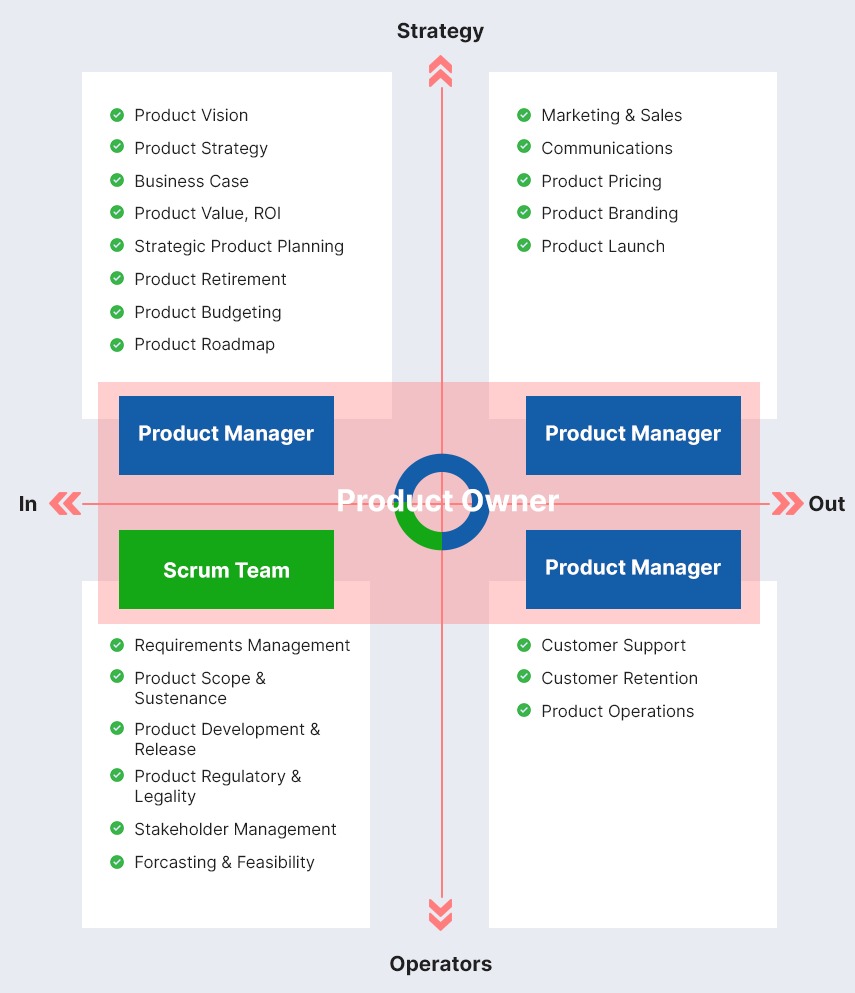
Sumeet Madan
With a remarkable 18-year tenure in software engineering, agile training, coaching, and consulting,... Read more
![]() Get Your AI-Enabled Scrum Master Certification for Just ₹1,500 (Save 85%)!
Get Your AI-Enabled Scrum Master Certification for Just ₹1,500 (Save 85%)!
Scrum.Org
SAFe®
ICAgile
Scrum Alliance
Technical Agility
Kanban
Business Analysis
Project Management
AI-Enabled
Agilemania Academy
Scrum.Org
SAFe®
ICAgile
Scrum Alliance
Technical Agility
Kanban
Business Analysis
Project Management
AI-Enabled

Sumeet Madan
With a remarkable 18-year tenure in software engineering, agile training, coaching, and consulting,... Read more

A Product Owner is a person who owns the Product and is accountable for its success. Product Owner responsibilities are often misunderstood in the market.
A Product Owner typically doesn’t have ownership of the product they are working on, and they aren’t empowered to make decisions regarding the Product.
They are primarily focused on writing the product requirements that are dictated by the stakeholder(s). These types of Product Owners are commonly referred to as Business Analysts.
Scrum Product Owner is a Role in Scrum and carries the accountability for maximizing the value of the Product/Success of the Product/ROI of the Product by
Clearly expressing Product Backlog items.
Ordering the items in the Product Backlog to best achieve goals and missions
Optimizing the value of the work the Development Team performs
Ensuring that the Product Backlog is visible, transparent, and clear to all, and shows what the Scrum Team will work on next, and
Ensuring the Development Team understands items in the Product Backlog to the level needed.
In this blog, we will understand the product owner role and responsibilities in detail. Therefore, stick with us until the end. We genuinely have a wealth of knowledge to offer your bank.
Many people ask, What are a Product Owner’s responsibilities? While the general assumption is that they only manage backlogs, their role goes much deeper, shaping the product vision, aligning teams, and ensuring customer satisfaction at every step.
The Scrum Guide describes the scrum product owner as the person who is in charge of maximizing the value of the product. The process is widely varied across organizations and individuals.
A product owner is an individual, not a team who may represent the needs of many stakeholders.
If anyone in the team wants any change in the product backlog, they need to convince the product owner and respect their decisions.
Before that, let’s understand what is a product backlog, and what it includes.
A product backlog is a to-do list with the details of every task that needs to be done to build the product.
It is an ongoing and continuous process, and it includes:
New features
Enhancement to existing functionalities
Technical debt
Infrastructure update
The product owner may do all the work by themselves or delegate to others, but regardless, the product owner is accountable for the entire process.
Before embarking on your journey as a product owner, it is essential to understand the key differences between a product owner and a product manager.
 You might be wondering, what is one of the Product Owner's responsibilities? The truth is, there’s no single answer.
You might be wondering, what is one of the Product Owner's responsibilities? The truth is, there’s no single answer.
From defining the product vision to reviewing team deliverables, a Product Owner wears many hats.
Let’s dive into the top 10 agile product owner responsibilities that define this critical role.
A product owner's responsibilities revolve around maximizing the value of a product by defining, prioritizing, and managing its features.
The Product Owner is a crucial part of Agile teams because they bridge the connection between the customer and the development team. It's not just about creating backlogs for them; it's also about ensuring the product is useful.
Here are the top 10 responsibilities of a product owner to ensure a project's success, from setting the vision to determining which tasks are most important.
As part of the product development team, the Product Owner is the key person responsible for defining goals and creating a vision for development projects.
Product Owners are responsible for liaising with stakeholders, including customers, business managers, and the development team. This is done to ensure that the goals are clear and the vision aligns with the business objectives.
The product backlog is a list that contains and prioritizes the details of every task you require to include in your product.
Formulating a list of backlog items and prioritizing them according to critical business objectives is the responsibility of the product owner.
They have to jot down the list of project dependencies to determine the sequence of product development. The product backlog is dynamic and will keep evolving as the project requirements change.
The product backlog should be made accessible to all stakeholders and developers for superior performance.
The Product Owner defines the sprint objective. The product owner defines the suggested sprint objective, which will serve as the basis to determine the sprint goal by the Scrum Master, Scrum Team, Product Owner, and the Development Team.
The product owner is responsible for managing the money. In addition, they manage the scope, releases, and stakeholders to ensure the project is delivered on time.
The product owner inspects the product increment made by the development team in each iteration.
The review is carried out to ensure if the work is as per the product vision. If it is satisfactory, then the work will need to be revised by the development team in the future sprints.
Pending or incomplete work will be prioritized and sequenced to deliver the expected outcomes from the user stories.
The Product Owner must be available to address the development team’s questions and queries regarding customer needs and perspectives to build the functionality effectively.
The Product Owner serves as the central communicator between the development team and stakeholders.
They need to be the best communicators to ensure there is approval of the stakeholders for all major decisions and strategies.
Clear communication is required to ensure there are instructions and deliverables for the development team.
Product Backlog Refinement is a repetitive meeting where product owners, product managers, and the engineering teams sit to prioritize, enhance, and finalize the items before the sprint planning.
The Product Owner collaborates with the development team to confirm shared understanding between all the people involved.
It is necessary to get an estimate of the size for the difficulty and implementation. Finally, the collaboration is done to determine if the items in the product backlog are done based on business value and the efforts needed.
Evidence-Based Management is a framework businesses can leverage to help them measure, manage, and increase the value they derive from their product delivery. It focuses on bettering outcomes, minimizing risks, and maximizing value.
The Product Owner should use EBM as it guides organizations to take the right measures to make the right investments in the correct places.
Additionally, it aids in making smart decisions and decreases risk with the help of an iterative and incremental method.
A Product Roadmap is the long-term visual summary of the vision and direction of your product offering with the passage of time.
The Product Owner owns the product roadmap. It gives an insight into the product’s current state to the internal teams and the stakeholders.
Get certified as a product owner and watch your earning potential soar! Open doors to higher-paying opportunities in agile environments. Take charge of your career growth now!
Register Today!
To be a successful Product Owner, you must master certain skills. These skills help you lead with clarity, align teams, and deliver products that truly meet user needs.
1. Product Management: Product Management refers to the functional department that oversees product strategy, development, planning, pricing, forecasting, launching, and marketing the product. Product management as a skill is helpful in-
Leading product management and performing business analysis and managing the product requirements in multiple emerging markets.
Building the requirements while communicating between businesses and developers.
Building digital product management enterprise tools.
2. Project Management: Project Management is the ability to apply knowledge, skills, techniques, and tools to accomplish project goals and fulfill objectives successfully. It is a 5 step process that consists of-
Initiating
Planning
Executing
Monitoring and controlling
Closing
3. Subject Matter Expertise: Domain knowledge is needed to become a product owner. The Product Owner is not an entry level job. You must have experience in programming, software development, agile methodology, scrum framework, business development, and project management.
The product owner is an integral part of the company because they help ensure projects are completed on time and efficiently. Some of the most important tasks of a product owner are making a project roadmap, meeting the needs of stakeholders, and successfully launching products.
If you're still unsure about your skills or feel stuck in your current job, we strongly recommend exploring our upcoming Scrum Product Owner training. It could help you move up in your career.
1. Product Management: Product Management refers to the functional department that oversees product strategy, development, planning, pricing, forecasting, launching, and marketing the product. Product management as a skill is helpful in-
2. Project Management: Project Management is the ability to apply knowledge, skills, techniques, and tools to accomplish project goals and fulfill objectives successfully. It is a 5 step process that consists of-
3. Subject Matter Expertise: Domain knowledge is needed to become a product owner. The Product Owner is not an entry level job. You must have experience in programming, software development, agile methodology, scrum framework, business development, and project management.
Access our expert-curated product owner assessment designed to help you achieve top scores in your exam. Stand out from the crowd and advance your career with confidence!
Take The Assessment!
A great Product Owner represents the customer's voice and creates a product vision together with the stakeholders. Every decision is taken with the product vision in mind. This ensures sustainable product development, provides clarity for the development team, and significantly increases the chances of product success.
In 2025, the role of the Product Owner is bigger and more exciting than ever. It's no longer just about writing user stories or filling the backlog. It's about being a leader, a problem-solver, and a voice for the customer. To keep up, Product Owners need to keep learning—about technology, teamwork, data, and AI.
“The Product Owner is higher in the hierarchy.”
These requirements often place them in a more senior role. Meanwhile, the Product Owner focuses on tactical execution and working closely with the development team to deliver value based on the strategic direction set by the Product Manager.
The Product Owner vs. Product Manager salary comparison reveals that both roles are well-compensated, although Product Managers may have a slightly higher earning potential due to the broader scope of their responsibilities.
While a technical background can be beneficial, it's not always a requirement. A strong understanding of the product domain and the ability to communicate effectively with technical teams are more crucial.
There's no single path to becoming a Product Owner. Many professionals transition from roles like project management, business analysis, or marketing. Gaining relevant experience, acquiring PSPO certification, and continuously learning about product development methodologies can help prepare you for this exciting role.
With a remarkable 18-year tenure in software engineering, agile training, coaching, and consulting, Sumeet's expertise is unparalleled. As a certified Professional Scrum Trainer (PST) from Scrum.org and a distinguished SAFe® Practice Consultant (SPC), Sumeet brings a wealth of knowledge and skill to every project, making a lasting impact on organizations seeking to embrace Agile methodologies.
WhatsApp Us
We will get back to you soon!
For a detailed enquiry, please write to us at connect@agilemania.com

